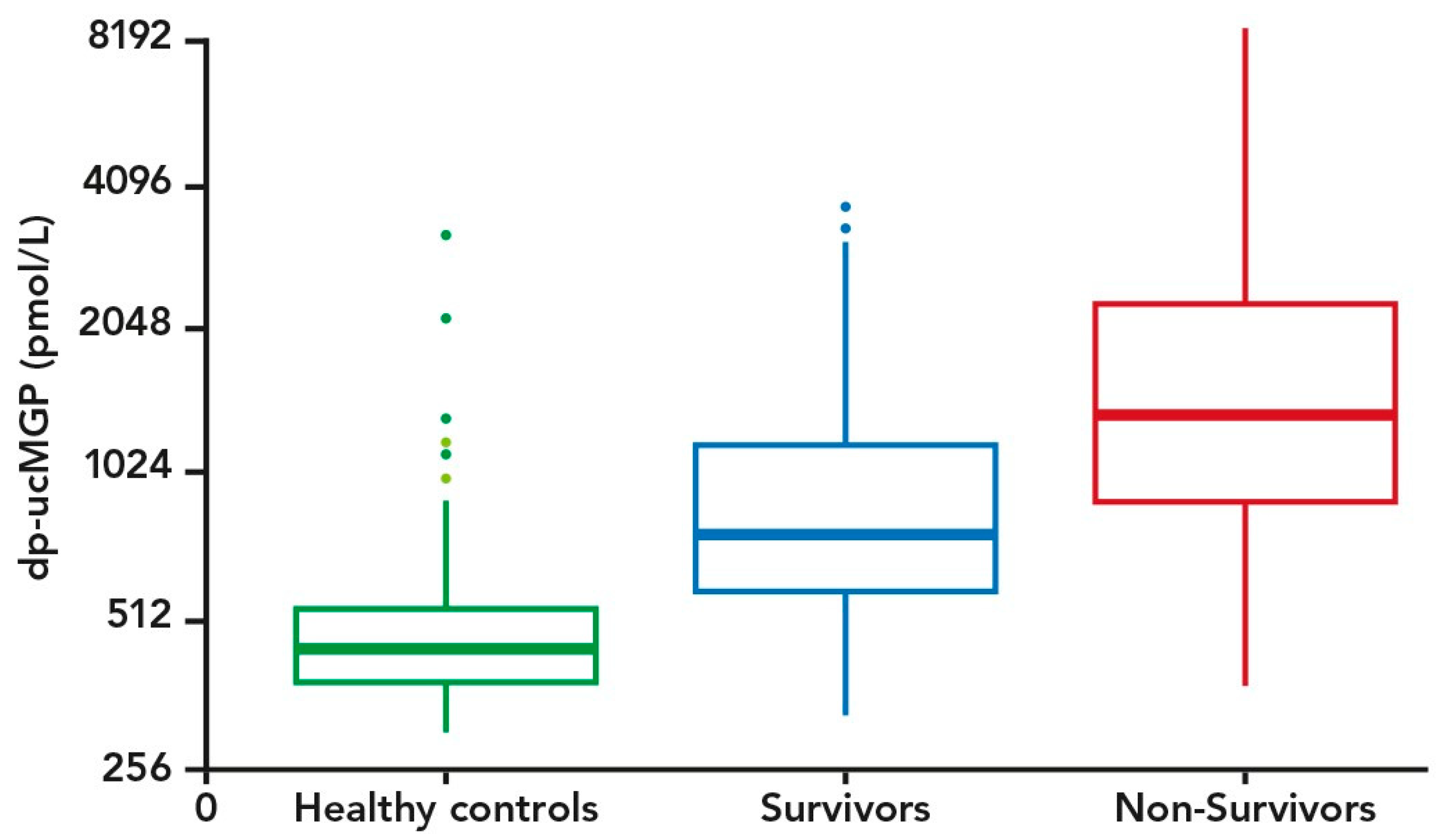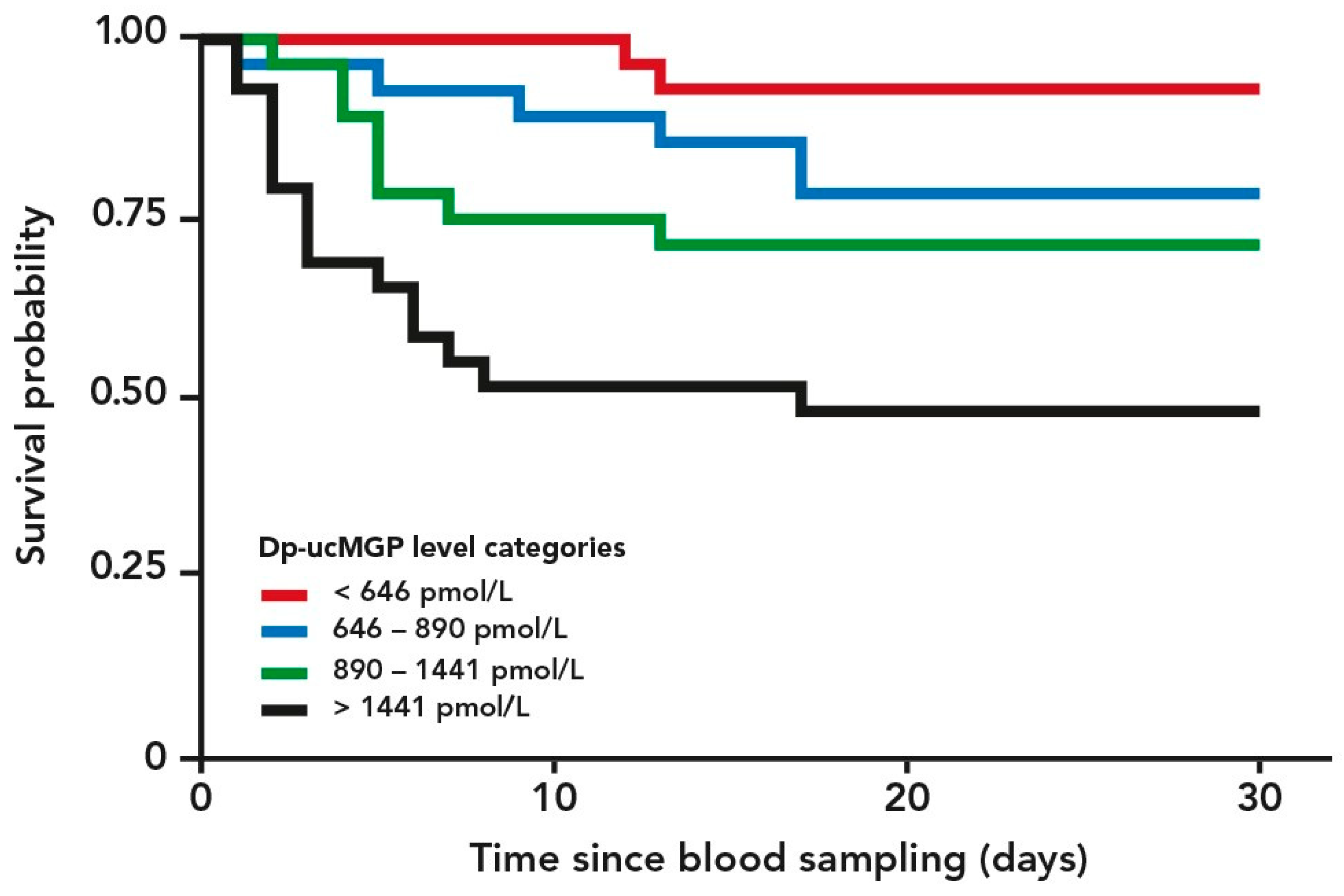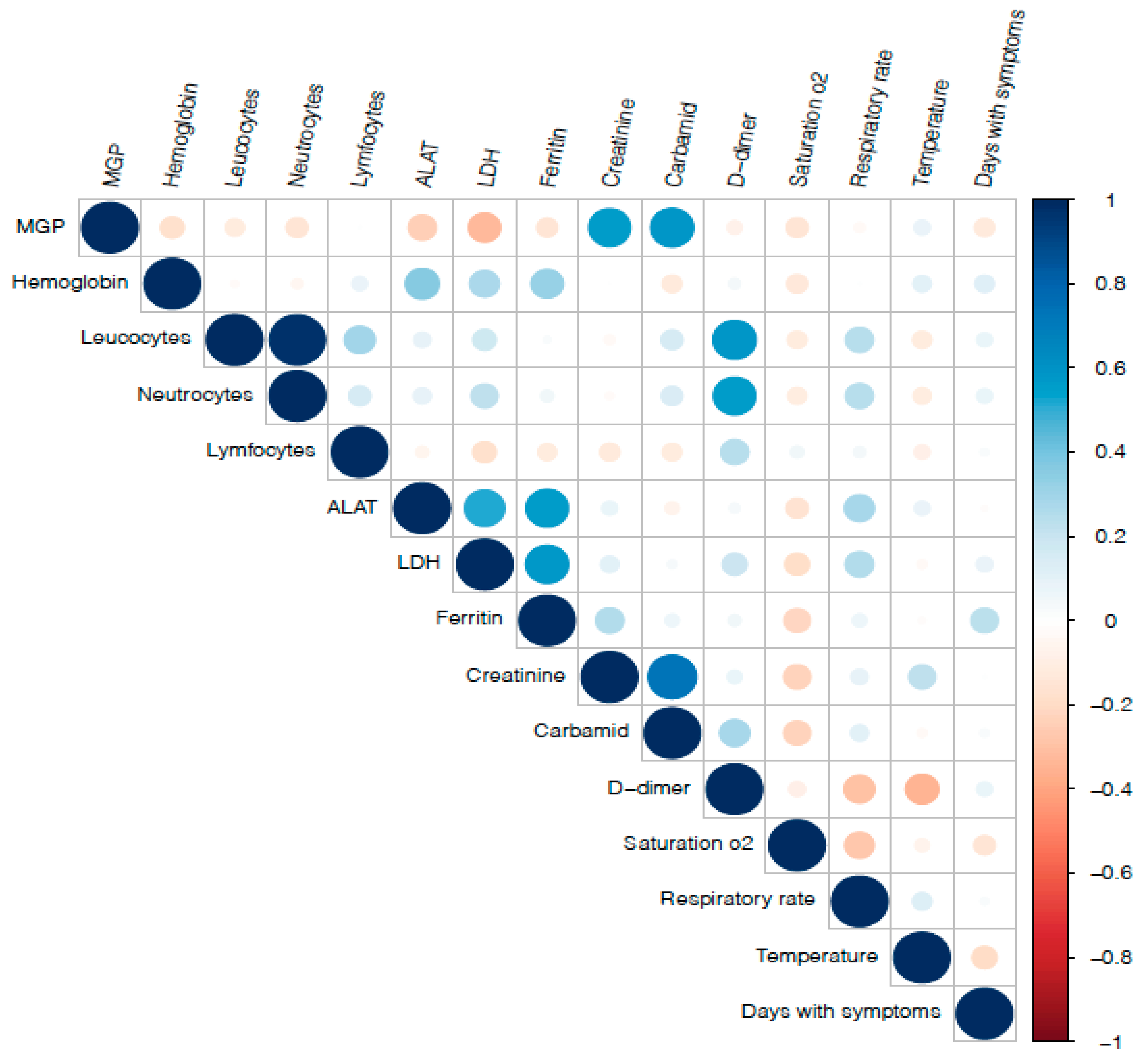The Association of Low Vitamin K Status with Mortality in a Cohort of 138 Hospitalized Patients with COVID-19
Abstract
1. Introduction
2. Materials and Methods
2.1. The Amager Hvidovre Hospital COVID-19 Cohort
2.2. General Population Controls
2.3. Measurements of Vitamin K Status in Plasma
2.4. Statistical Analyses
3. Results
4. Discussion
Author Contributions
Funding
Institutional Review Board Statement
Informed Consent Statement
Data Availability Statement
Acknowledgments
Conflicts of Interest
References
- Dattola, A.; Silvestri, M.; Bennardo, L.; Passante, M.; Scali, E.; Patruno, C.; Nisticò, S.P. Role of Vitamins in Skin Health: A Systematic Review. Curr. Nutr. Rep. 2020, 9, 226–235. [Google Scholar] [CrossRef]
- Theuwissen, E.; Cranenburg, E.C.; Knapen, M.H.; Magdeleyns, E.J.; Teunissen, K.J.; Schurgers, L.J.; Smit, E.; Vermeer, C. Low-Dose Menaquinone-7 Supplementation Improved Extra-Hepatic Vitamin K Status, But Had No Effect on Thrombin Generation in Healthy Subjects. Br. J. Nutr. 2012, 108, 1652–1657. [Google Scholar] [CrossRef]
- Jespersen, T.; Møllehave, L.T.; Thuesen, B.H.; Skaaby, T.; Rossing, P.; Toft, U.; Jørgensen, N.R.; Corfixen, B.L.; Jakobsen, J.; Frimodt-Møller, M.; et al. Uncarboxylated Matrix Gla-Protein: A Biomarker of Vitamin K Status and Cardiovascular Risk. Clin. Biochem. 2020, 83, 49–56. [Google Scholar] [CrossRef]
- Dastoli, S.; Bennardo, L.; Patruno, C.; Nisticò, S.P. Are Erythema Multiforme and Urticaria Related to a Better Outcome of COVID-19? Dermatol. Ther. 2020, 33, e13681. [Google Scholar] [CrossRef]
- Wiersinga, W.J.; Rhodes, A.; Cheng, A.C.; Peacock, S.J.; Prescott, H.C. Pathophysiology, Transmission, Diagnosis, and Treatment of Coronavirus Disease 2019 (COVID-19): A Review. JAMA J. Am. Med. Assoc. 2020, 324, 782–793. [Google Scholar] [CrossRef]
- Dofferhoff, A.S.M.; Piscaer, I.; Schurgers, L.J.; Visser, M.P.J.; van den Ouweland, J.M.W.; de Jong, P.A.; Gosens, R.; Hackeng, T.M.; van Daal, H.; Lux, P.; et al. Reduced Vitamin K Status as a Potentially Modifiable Risk Factor of Severe COVID-19. Clin. Infect. Dis. Off. Publ. Infect. Dis. Soc. Am. 2020. [Google Scholar] [CrossRef]
- Piscaer, I.; van den Ouweland, J.M.W.; Vermeersch, K.; Reynaert, N.L.; Franssen, F.M.E.; Keene, S.; Wouters, E.F.M.; Janssens, W.; Vermeer, C.; Janssen, R. Low Vitamin K Status Is Associated with Increased Elastin Degradation in Chronic Obstructive Pulmonary Disease. J. Clin. Med. 2019, 8, 1116. [Google Scholar] [CrossRef]
- Piscaer, I.; Wouters, E.F.M.; Vermeer, C.; Janssens, W.; Franssen, F.M.E.; Janssen, R. Vitamin K Deficiency: The Linking Pin between COPD and Cardiovascular Diseases? Respir. Res. 2017, 18, 1–7. [Google Scholar] [CrossRef] [PubMed]
- Fraser, J.D.; Price, P.A. Lung, Heart, and Kidney Express High Levels of MRNA for the Vitamin K-Dependent Matrix Gla Protein. Implications for the Possible Functions of Matrix Gla Protein and for the Tissue Distribution of the γ-Carboxylase. J. Biol. Chem. 1988, 263, 11033–11036. [Google Scholar] [CrossRef]
- Janssen, R.; Visser, M.P.J.; Dofferhoff, A.S.M.; Vermeer, C.; Janssens, W.; Walk, J. Vitamin K Metabolism as the Potential Missing Link between Lung Damage and Thromboembolism in Covid-19. Br. J. Nutr. 2020, 1–25. [Google Scholar] [CrossRef] [PubMed]
- Basalyga, D.M.; Simionescu, D.T.; Xiong, W.; Baxter, B.T.; Starcher, B.C.; Vyavahare, N.R. Elastin Degradation and Calcification in an Abdominal Aorta Injury Model: Role of Matrix Metalloproteinases. Circulation 2004, 110, 3480–3487. [Google Scholar] [CrossRef]
- Caluwé, R.; Verbeke, F.; De Vriese, A.S. Evaluation of Vitamin K Status and Rationale for Vitamin K Supplementation in Dialysis Patients. Nephrol. Dial. Transplant. 2020, 35, 23–33. [Google Scholar] [CrossRef]
- Burstyn-Cohen, T.; Heeb, M.J.; Lemke, G. Lack of Protein S in Mice Causes Embryonic Lethal Coagulopathy and Vascular Dysgenesis. J. Clin. Investig. 2009, 119, 2942–2953. [Google Scholar] [CrossRef] [PubMed]
- Theuwissen, E.; Smit, E.; Vermeer, C. The Role of Vitamin K in Soft-Tissue Calcification. Adv. Nutr. 2012, 3, 166–173. [Google Scholar] [CrossRef] [PubMed]
- Israelsen, S.B.; Kristiansen, K.T.; Hindsberger, B.; Ulrik, C.S.; Andersen, O.; Jensen, M.; Andersen, S.; Rasmussen, C.; Jørgensen, H.L.; Østergaard, C.; et al. Characteristics of Patients with COVID-19 Pneumonia at Hvidovre Hospital, March-April 2020. Dan. Med. J. 2020, 67, A05200313. [Google Scholar]
- Leth-Møller, K.B.; Skaaby, T.; Linneberg, A. Allergic Rhinitis and Allergic Sensitisation Are Still Increasing among Danish Adults. Allergy 2020, 75, 660–668. [Google Scholar] [CrossRef] [PubMed]
- Grambsch, P.M.; Therneau, T.M. Proportional Hazards Tests and Diagnostics Based on Weighted Residuals. Biometrika 1994, 81, 515–526. [Google Scholar] [CrossRef]
- Selistre, L.; Rabilloud, M.; Cochat, P.; de Souza, V.; Iwaz, J.; Lemoine, S.; Beyerle, F.; Poli-de-Figueiredo, C.E.; Dubourg, L. Comparison of the Schwartz and CKD-EPI Equations for Estimating Glomerular Filtration Rate in Children, Adolescents, and Adults: A Retrospective Cross-Sectional Study. PLoS Med. 2016, 13, e1001979. [Google Scholar] [CrossRef]
- Cui, S.; Chen, S.; Li, X.; Liu, S.; Wang, F. Prevalence of Venous Thromboembolism in Patients with Severe Novel Coronavirus Pneumonia. J. Thromb. Haemost. 2020, 18, 1421–1424. [Google Scholar] [CrossRef]
- Tang, N.; Li, D.; Wang, X.; Sun, Z. Abnormal Coagulation Parameters Are Associated with Poor Prognosis in Patients with Novel Coronavirus Pneumonia. J. Thromb. Haemost. 2020, 18, 844–847. [Google Scholar] [CrossRef]
- Mazzeffi, M.; Chow, J.H.; Amoroso, A.; Tanaka, K. Revisiting the Protein C Pathway: An Opportunity for Adjunctive Intervention in COVID-19? Anesth. Analg. 2020, 131, 690–693. [Google Scholar] [CrossRef]
- Poissy, J.; Goutay, J.; Caplan, M.; Parmentier, E.; Duburcq, T.; Lassalle, F.; Jeanpierre, E.; Rauch, A.; Labreuche, J.; Susen, S. Pulmonary Embolism in Patients with COVID-19: Awareness of an Increased Prevalence. Circulation 2020, 142, 184–186. [Google Scholar] [CrossRef] [PubMed]
- Petrilli, C.M.; Jones, S.A.; Yang, J.; Rajagopalan, H.; O’Donnell, L.; Chernyak, Y.; Tobin, K.A.; Cerfolio, R.J.; Francois, F.; Horwitz, L.I. Factors Associated with Hospital Admission and Critical Illness among 5279 People with Coronavirus Disease 2019 in New York City: Prospective Cohort Study. BMJ 2020, 369, m1966. [Google Scholar] [CrossRef] [PubMed]
- Morales, A.; Rojo Rello, S.; Cristóbal, H.; Fiz-López, A.; Arribas, E.; Marí, M.; Tutusaus, A.; de la Cal-Sabater, P.; Nicolaes, G.A.F.; Ortiz-Pérez, J.T.; et al. Growth Arrest-Specific Factor 6 (GAS6) Is Increased in COVID-19 Patients and Predicts Clinical Outcome. Biomedicines 2021, 9, 335. [Google Scholar] [CrossRef] [PubMed]



| COVID-19 Non-survivor Patients (n = 43) | COVID-19 Survivor Patients (n = 95) | p-Value # | COVID-19 Patients Total (n = 138) | Population Controls (n = 138) | p-Value * | ||
|---|---|---|---|---|---|---|---|
| Age | Mean (SD) | 76.6 (11.5) | 64.7 (15.8) | <0.0001 | 68.4 (15.6) | 62.5 (10.6) | 0.0002 |
| Sex | Male | 19 (44.2) | 40 (42.1) | 59 (42.8) | 59 (42.8) | 1 | |
| Female | 24 (55.8) | 55 (57.9) | 0.9656 | 79 (57.2) | 79 (57.2) | ||
| BMI | mean (SD) | 29.2 (6.5) | 28.8 (6.8) | 0.7244 | 28.9 (6.6) | 26.5 (5.3) | 0.0016 |
| Obesity | BMI ≥ 30 | 15 (41.7) | 31 (37.8) | 46 (39.0) | 23 (16.7) | 0.0001 | |
| BMI < 30 | 21 (58.3) | 51 (62.2) | 0.8484 | 72 (61.0) | 115 (83.3) | ||
| Hypertension | No | 15 (34.9) | 57 (60.0) | 72 (52.2) | 45 (32.6) | 0.0015 | |
| Yes | 28 (65.1) | 38 (40.0) | 0.0107 | 66 (47.8) | 93 (67.4) | ||
| Diabetes | No | 28 (65.1) | 68 (71.6) | 96 (69.6) | 129 (93.5) | <0.0001 | |
| Yes | 15 (34.9) | 27 (28.4) | 0.5724 | 42 (30.4) | 9 (6.5) | ||
| CVD | No | 13 (30.2) | 48 (50.5) | 61 (44.2) | 106 (90.6) | <0.0001 | |
| Yes | 30 (69.8) | 47 (49.5) | 0.0415 | 77 (55.8) | 11 (9.4) | ||
| Asthma/COPD | No | 32 (74.4) | 78 (82.1) | 110 (79.7) | 99(85.3) | 0.3141 | |
| Yes | 11 (25.6) | 17 (17.9) | 0.4171 | 28 (20.3) | 17(14.7) | ||
| Vitamin K antagonist user | No Yes | 41 (95.3) 2 (4.7) | 93 (97.9) 2 (2.1) | 0.7811 | 134 (97.1) 4 (2.9) | 136 (98.6) 2 (1.4) | 0.6798 |
| eGFR (mL/min/1.73 m2) | Mean (95% CI) | 47.2 (41.6; 52.8) | 65.6 (61.1; 70.1) | <0.0001 | 60.7 (56.7; 64.7) | 81.1 (78.6; 83.6) | <0.0001 |
| Dp-ucMGP (pmol/L) | Median (IQR) | 1368 (889; 2340) | 771 (590; 1174) | 0.0002 | 889 (646; 1441) | 506.5 (417.0; 617.2) | <0.0001 |
| Dp-ucMGP (pmol/L) | Mean (95% CI) | 1445 (1148; 1820) | 877 (778; 995) | <0.0001 | 1022 (912; 1151) | 533 (498; 571) | <0.0001 |
Publisher’s Note: MDPI stays neutral with regard to jurisdictional claims in published maps and institutional affiliations. |
© 2021 by the authors. Licensee MDPI, Basel, Switzerland. This article is an open access article distributed under the terms and conditions of the Creative Commons Attribution (CC BY) license (https://creativecommons.org/licenses/by/4.0/).
Share and Cite
Linneberg, A.; Kampmann, F.B.; Israelsen, S.B.; Andersen, L.R.; Jørgensen, H.L.; Sandholt, H.; Jørgensen, N.R.; Thysen, S.M.; Benfield, T. The Association of Low Vitamin K Status with Mortality in a Cohort of 138 Hospitalized Patients with COVID-19. Nutrients 2021, 13, 1985. https://doi.org/10.3390/nu13061985
Linneberg A, Kampmann FB, Israelsen SB, Andersen LR, Jørgensen HL, Sandholt H, Jørgensen NR, Thysen SM, Benfield T. The Association of Low Vitamin K Status with Mortality in a Cohort of 138 Hospitalized Patients with COVID-19. Nutrients. 2021; 13(6):1985. https://doi.org/10.3390/nu13061985
Chicago/Turabian StyleLinneberg, Allan, Freja Bach Kampmann, Simone Bastrup Israelsen, Liv Rabøl Andersen, Henrik Løvendahl Jørgensen, Håkon Sandholt, Niklas Rye Jørgensen, Sanne Marie Thysen, and Thomas Benfield. 2021. "The Association of Low Vitamin K Status with Mortality in a Cohort of 138 Hospitalized Patients with COVID-19" Nutrients 13, no. 6: 1985. https://doi.org/10.3390/nu13061985
APA StyleLinneberg, A., Kampmann, F. B., Israelsen, S. B., Andersen, L. R., Jørgensen, H. L., Sandholt, H., Jørgensen, N. R., Thysen, S. M., & Benfield, T. (2021). The Association of Low Vitamin K Status with Mortality in a Cohort of 138 Hospitalized Patients with COVID-19. Nutrients, 13(6), 1985. https://doi.org/10.3390/nu13061985







